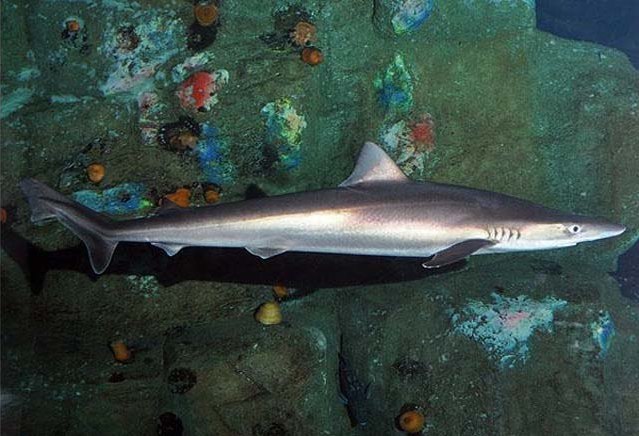Mediterranean Sharks and Rays

Overview
As apex predators, sharks play a key role in regulating marine ecosystems. Despite this, recognition and appreciation for the role sharks play in the stability of these habitats is generally understated. This matter provides a frequent hurtle in the efforts to protect and conserve these vital spices. Sharks are a collectively misunderstood inhabitant of our oceans and are often villainized in modern media whereas, in reality, they are the victims. On average, around the world, humans kill 100 million sharks a year and with a global decline in abundance, marine ecosystems are likely to be affected, leading to the decline of other commercially important species. Abundance in the Mediterranean Sea is also decreasing at an alarming rate, despite their status of protection which is weakly enforced. Efficient protection measures to halt the decline of the Mediterranean shark populations is of utmost priority in order to prevent any further losses to biodiversity.
Records of sharks in the Mediterranean date back to the Middle Ages. The majority of species now found are smaller-sized sharks, which occupy lower trophic levels of the food chain. Large predatory sharks in the Mediterranean Sea are thought to be functionally non-existent, but some species cluster in regions around the Mediterranean. The Mediterranean Sea is an important hotspot for shark conservation. A total of nine out of the 16 species most often caught by fishermen (both legally and illegally), are more threatened regionally than they are globally. There exists insignificant data on the total catch rate of sharks in the Mediterranean, as incidental bycatch often goes unreported. Some of the species most often found victim to bycatch in the Mediterranean include the catshark, gulper shark, bluntnose sixgill shark, blue shark, shortfin mako shark and thresher shark.
There are 47 species of sharks inhabiting the Mediterranean Sea, with over one third of them classified as threatened. Mediterranean shark stocks are considered close to being fully exploited.
- Bycatch, the capture of species other than those being targeted, is the greatest threat to the survival of shark populations in Greece. Intense fishing efforts in the Mediterranean are causing a drastic decline in shark populations and as efforts increase with demand, the number of sharks being impacted escalates tenfold. Different fishing methods such as longline, trawlers, and nets can have profound effects on species depletion.
- Sharks in the Mediterranean Sea are also threatened by targeted fishing practices as fishermen are becoming aware of their commercial value. As fish stocks are declining due to overfishing, sharks are often substitutes in the commercial market. It has been observed that shortfin mako is marketed as swordfish in cases of seafood fraud due to the resemblance of the meat. One study in Italy found 20% of commercially sold swordfish to actually be shark meat.
- Shark fins remain in global demand. The practice of shark finning removes the dorsal fin of the shark prior to discarding the remaining, less valuable carcass, overboard. Sharks must swim continuously to prevent drowning, but when their fins are severed they are unable to do so, and drown. In 2005, the practice of shark finning was banned in the Mediterranean; however a loophole in removal of fins at sea has led to the continuation of this practice.
- The bioaccumulation of pollutants through the food chain threatens the survival of sharks. As sharks occupy the highest trophic level, bioaccumulation leads to high concentrations of dangerous pollutants in their tissue. Heavy metals as well as plastics can be found within these individuals.
- Climate change has been shown to affect prey distribution and ocean currents. This affects the abundance and distribution of sharks, often limiting the habitats they are able to survive in. With climate change causing the oceans to warm at rates unseen before, the effects on marine ecosystems and species are not entirely known, but are likely to be detrimental.
Many shark species are protected in the Mediterranean, and in the Greek seas in particular, under the Bonn Convention, CITES, UNCLOS, UNFSA, the Bern Convention and the Barcelona Convention. In addition, there is a total ban on drift netting and shark finning. Whole sharks must now be landed to encourage the use of their entire body, and the weight of the fins must not exceed 5% of the total weight of the catch. In many countries a permit system has been introduced for shark fishing.
However, in order to improve the current status of sharks in the Greek seas, better monitoring and landing guidelines are necessary. There is a need for a management plan to be implemented, as well as public education and raising awareness in order to dispel the negative image associated with sharks.
Conservation
Many shark species are protected in the Mediterranean, and in the Greek seas in particular, under the Bonn Convention, CITES, UNCLOS, UNFSA, the Bern Convention and the Barcelona Convention. In addition, there is a total ban on drift netting and shark finning. Whole sharks must now be landed to encourage the use of their entire body, and the weight of the fins must not exceed 5% of the total weight of the catch. In many countries a permit system has been introduced for shark fishing.
However, in order to improve the current status of sharks in the Greek seas, better monitoring and landing guidelines are necessary. There is a need for a management plan to be implemented, as well as public education and raising awareness in order to dispel the negative image associated with sharks.
Species
- Angelshark
- Angular roughshark
- Basking shark
- Bigeye Thresher shark
- Blackchin guitarfish
- Blackspotted smooth-hound
- Blue shark
- Bluntnose sixgill shark
- Bottlenose skate
- Common guitarfish
- Common skate
- Devil fish
- Great hammerhead
- Great White shark
- Gulper shark
- Maltese skate
- Picked dogfish
- Porbeagle shark
- Sand tiger shark
- Sandbar shark
- Sandy ray
- Sawback angelshark
- Scalloped hammerhead
- Sharpnose sevengill shark
- Shortfin Mako shark
- Smalltooth sandtiger
- Smooth hammerhead
- Smooth-hound
- Smoothback angelshark
- Spiny butterfly ray
- Starry smooth-hound
- Thresher shark
- Tope
Common Name
Angelshark
Scientific Name
Squatina squatina
Main Threats
The main threat to angel sharks is bottom trawling, a form of fishing that scrapes the seafloor devoid of life. As angel sharks reside on the bottom of the sea floor, they are very vulnerable to this widely used fishing method.
Habitat
Benthic coastal and continental shelf
LifeSpan
25-35 years
weight
~35 kg
Length
91-122 cm
DIET
Bony fish, crustaceans, mollusks, and cephalapods.
status (iucn)
Critically endangered
POPULATION TRENDS
Decreasing
further information
Angel sharks camoflauge into the sand, where they wait for their prey for periods up to a few days, but strike passing prey within a tenth of a second.
is fishing allowed in greece?
No


Common Name
Angular roughshark
Scientific Name
Oxynotus centrina
Main Threats
The angular roughshark is being targeted by fisheries for its meat and oil.
Habitat
Inhabits the upper slopes and outer continental shelf. Depth range: 60 – 1309m.
LifeSpan
Unknown
weight
Unknown
Length
0.55 m
DIET
Polychaetes, sipunculids
status (iucn)
Endangered
POPULATION TRENDS
Decreasing
further information
Usually angular roughshark move by gliding on the bottom of the sea, sometimes hovering over the sandy or muddy surfaces of the seabed. They feed on worms, crustaceans, and mollusks.
is fishing allowed in greece?
No

Common Name
Basking shark
Scientific Name
Cetorhinus maximus
Main Threats
Due to their size, basking sharks are threatened by boat strikes, in additon to entanglement in fishing gear. In some regions, they are hunted for their fins. As filter feeders, basking sharks are also influencded by high levels of microplastics in the ocean.
Habitat
Found on continental and insular shelves, offshore and often close to land. Coastal-pelagic species found at 1m – 1000m depth.
LifeSpan
50 years
weight
5000 kg
Length
7 m
DIET
Plankton
status (iucn)
Endangered
POPULATION TRENDS
Decreasing
further information
Basking sharks have been observed leaping out of the water, which is presumed to be a method of getting rid of parasites.
is fishing allowed in greece?
No
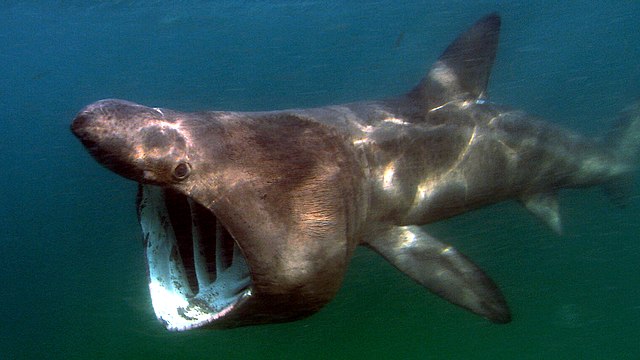

Common Name
Bigeye thresher shark
Scientific Name
Alopias superciliosus
Main Threats
Bigeye Thresher sharks are threatened by high levels of bycatch in commercial and recreational fisheries.
Habitat
Pelagic species, found in coastal waters over continental shelves, sometimes in shallow waters. Depth range: 0 – 723 m.
LifeSpan
19 years for female, 20 for male
weight
160 kg
Length
4 m
DIET
Schooling fish such as mackeral and tuna, squid, and cuttlefish
status (iucn)
Vulnerable
POPULATION TRENDS
Decreasing
further information
Thresher sharks have a distinctly long tail, which they use to stun their prey
is fishing allowed in greece?
No

Common Name
Blackchin guitarfish
Scientific Name
Glaucostegus cemiculus
Main Threats
Overfishing and deterioration of their habitat
Habitat
Inhabits muddy and sandy substrates. Depth range: 9 – 100 m.
LifeSpan
Unknown
weight
49.9 kg
Length
1.5 m
DIET
Crustaceans and small fishes
status (iucn)
Critically endangered
POPULATION TRENDS
Decreasing
further information
Have guitar shape, giving them their common name
is fishing allowed in greece?
Yes


Common Name
Blackspotted smooth-hound
Scientific Name
Mustelus punctulatus
Main Threats
Targeted for flesh, fins and liver oil
Habitat
Inhabits the bottom of continental shelves near the coast
LifeSpan
Unknown
weight
Unknown
Length
1.2 m
DIET
Crustaceans
status (iucn)
Vulnerable
POPULATION TRENDS
Decreasing
further information
None
is fishing allowed in greece?
Yes

Common Name
Blue shark
Scientific Name
Prionace glauca
Main Threats
Blue sharks are threatened by fisheries, specifically long line fisheries, which often target tuna, but catch this and other shark species as bycatch. Blue sharks are also believed to be shortening their vertical depth range in response to climate change, further exposing them to fishing.
Habitat
Oceanic, but may be found close inshore where the continental shelf is narrow. Usually found to at least 150 m. Depth range: 0 – 1082 m.
LifeSpan
Believed to be about 20 years
weight
110 kg
Length
3.35 m
DIET
Squid, herring, dolphin and whale carcasses
status (iucn)
Critically endangered in the Mediterranean
POPULATION TRENDS
Decreasing
further information
Blue sharks are actually blue! They have a distinct indigo coloration
is fishing allowed in greece?
Yes
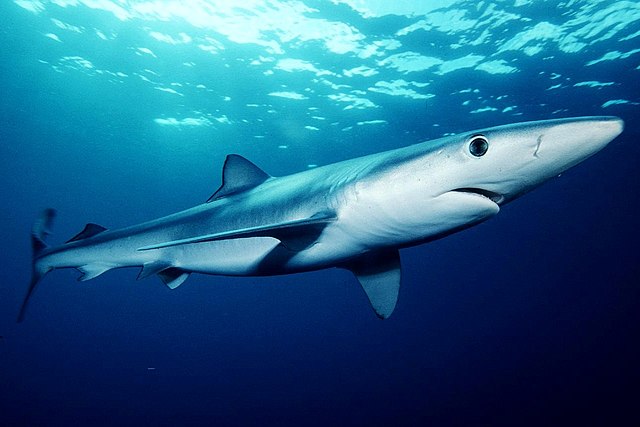

Common Name
Bluntnose sixgill shark
Scientific Name
Hexanchus griseus
Main Threats
Bluntnose sixgills are threatened by increasing anthropogenic pressure such as fisheries and climate change. In additon, as slow swimmers they are threatened by their predators- orcas.
Habitat
Found near the bottom of continental and outer island shelves, seamounts and mid-ocean ridges. Occasionally pelagic. Depth range 1 – 2500 m.
LifeSpan
80 years
weight
590 kg
Length
3 m
DIET
Dolphinfish, flounder, billfish
status (iucn)
Near threatened
POPULATION TRENDS
Decreasing
further information
Most sharks have 5 gill slits, but this shark has 6, giving them their name
is fishing allowed in greece?
No
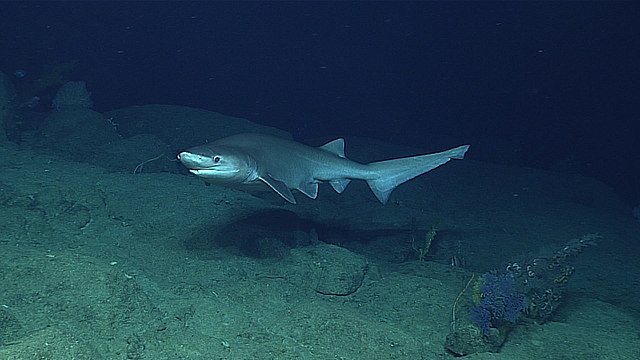

Common Name
Bottlenose skate
Scientific Name
Rostroraja alba
Main Threats
Bycatch and intentional capture
Habitat
Inhabits sand and rock-sand substrates. Depth range 30 – 600 m.
LifeSpan
Unknown
weight
Unknown
Length
2 – 2.3 m
DIET
Bony fish, crustaceans
status (iucn)
Endangered
POPULATION TRENDS
Decreasing
further information
The upper part is grey with small white spots. The snout is covered with small sharp thorns.
is fishing allowed in greece?
No

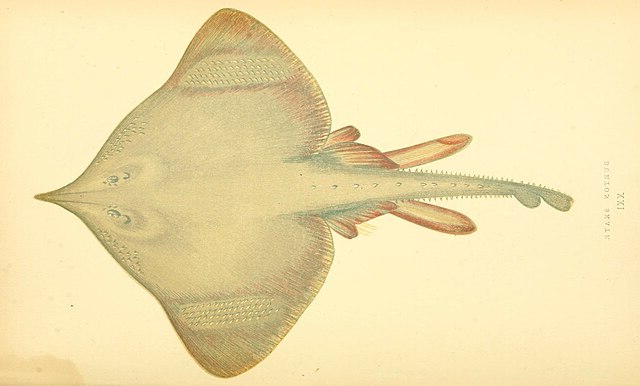
Common Name
Common guitarfish
Scientific Name
Rhinobatos rhinobatos
Main Threats
Commercial fishing and subsistence fishing
Habitat
Inhabits muddy and sandy substrates. Sometimes found near rocky reefs. Depth range: 0 – 100 m.
LifeSpan
35 years
weight
26.6 kg
Length
0.8 m
DIET
Crustaceans and small fishes
status (iucn)
Critically endangered
POPULATION TRENDS
Decreasing
further information
A mouth located on the bottom of the disc is well placed for eating bottom dwelling prey, but breathing through it would destroy a guitarfish’s delicate gills. Instead, guitarfish pump water in through holes (spiracles) on top of their heads, over the gills, and out through gill openings on the bottom of the disc.
is fishing allowed in greece?
No


Common Name
Common skate
Scientific Name
Dipturus batis
Main Threats
Threatened due to by-catch and target species
Habitat
Inhabits the seafloor of the continental shelf. Depth range: 10 – 1000 m.
LifeSpan
Unknown
weight
113 kg
Length
1 m
DIET
Fish and bottom invertebrates
status (iucn)
Critically endangered
POPULATION TRENDS
Decreasing
further information
The largest skate species
is fishing allowed in greece?
No
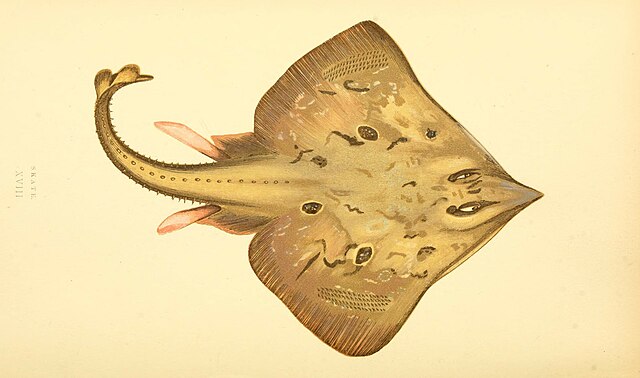
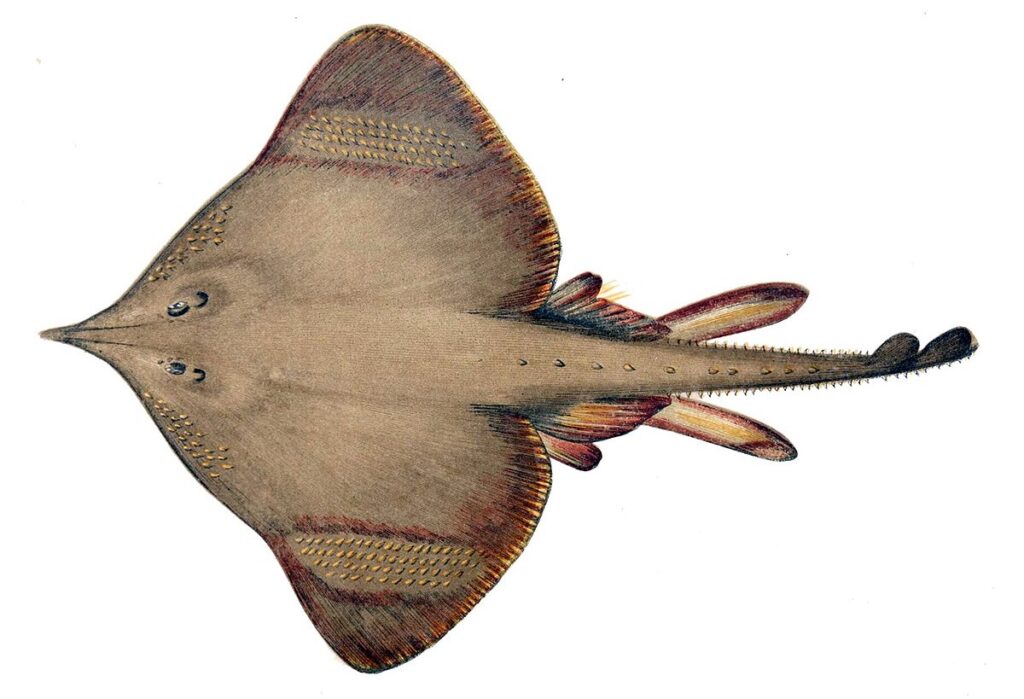
Common Name
Devil fish
Scientific Name
Mobula mobular
Main Threats
Bycatch and intentional capture
Habitat
Epipelagic species that inhabit open water over the continental shelves
LifeSpan
Unknown
weight
360 kg
Length
3 m
DIET
Fishes and crustaceans
status (iucn)
Endangered
POPULATION TRENDS
Decreasing
further information
According to fossil records it’s believed that devil rays have been around for around 20-25 million years. The latter is where they get their name from; when not feeding, their cephalic fins are curled and point forward and down, giving the appearance of devil horns.
is fishing allowed in greece?
No


Common Name
Great hammerhead
Scientific Name
Sphyrna mokarran
Main Threats
Habitat loss, target comercial fishing and by-catch
Habitat
Found over continental shelves, island terraces and in passes and lagoons. often in the bottom and associated to reefs associated. Depth range: 1 – 300m.
LifeSpan
30 years
weight
230 kg
Length
4 m
DIET
Preference to stingrays and other batoids, groupers and sea catfishes, but also preys on small bony fish, crabs, squid, lobsters, other sharks and rays.
status (iucn)
Critically endangered
POPULATION TRENDS
Decreasing
further information
They have a vision of 360º because of the position of their eyes, situated on the end of their heads. They also congregate in large schools during annual migration.
is fishing allowed in greece?
No
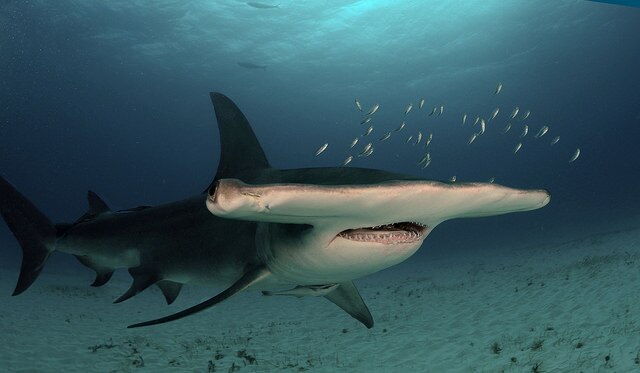

Common Name
Great white shark
Scientific Name
Carcharodon carcharias
Main Threats
Bycatch is a main threat to great white sharks, but also loss of prey due to overfishing
Habitat
Inhabits inshore and offshore waters of continental and insular shelves. Depth range: 0 – 1200 m.
LifeSpan
70 years
weight
680 – 1800 kg
Length
4 – 7 m
DIET
Other sharks, seabirds, marine mammals, seaturtles, crustaceans, molluscs
status (iucn)
Critically endangered
POPULATION TRENDS
Decreasing
further information
Probably the most known and demonized species, though attacks on humans by white sharks happen less then 10 times globally
is fishing allowed in greece?
No

Common Name
Gulper shark
Scientific Name
Centrophorus granulosus
Main Threats
Targeted by fisheries for flesh and liver oil, also threatened by bycatch
Habitat
Benthic species inhabiting outer continental shelves and upper slopes. Depth range: 50 – 1500 m.
LifeSpan
Unknown
weight
Unknown
Length
1.7 m
DIET
Bony fishes, squid, crustaceans
status (iucn)
Endangered
POPULATION TRENDS
Decreasing
further information
Gulper sharks have large green eyes, which help them see through the murky deep waters
is fishing allowed in greece?
Yes


Common Name
Maltese skate
Scientific Name
Leucoraja melitensis
Main Threats
By-catch by bottom trawlers and longliners
Habitat
Inhabits muddy and sandy substrates. Depth range: 60 – 800 m.
LifeSpan
Unknown
weight
Unknown
Length
0.45 – 0.52 m
DIET
Crustaceans (mainly amphipods)
status (iucn)
Critically endangered
POPULATION TRENDS
Decreasing
further information
Endemic species of the Mediterranian Sea, which makes them even more vulnerable.
is fishing allowed in greece?
No
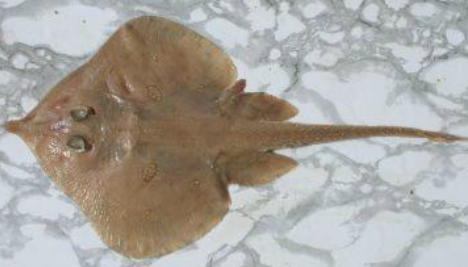
Common Name
Picked dogfish
Scientific Name
Squalus acanthias
Main Threats
This species is targeted by fisheries for its liver, hide, fins and meat.
Habitat
Usually found near the bottom, but also in midwater and at the surface, inshore and offshore of the continental shelves. Depth range: 0 – 1978m.
LifeSpan
75 years
weight
9 kg
Length
1 m
DIET
Comb jellyfish, squid, mackarel, herring, benthic fishes, crabs, shrimps, sea cucumbers
status (iucn)
Vulnerable
POPULATION TRENDS
Decreasing
further information
The only species of horned sharks that can inflict toxins with its tail.
is fishing allowed in greece?
Yes
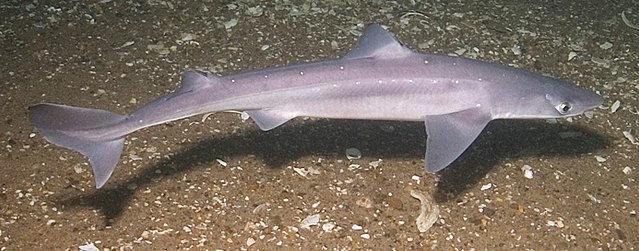

Common Name
Porbeagle shark
Scientific Name
Lamna nasus
Main Threats
Porbeagle sharks are threatened by targetted fisheries as well as bycatch. They are targetted for leather and fish meal.
Habitat
It is a migratory species that usually spends the summers inshore and the winters offshore in deeper waters. Depth range: 0 – 1360 m.
LifeSpan
65 years
weight
135 kg
Length
2.4 m
DIET
Mackerel, herring, cod
status (iucn)
Vulnerable
POPULATION TRENDS
Declining
further information
Porbeagles have a third eyelid
is fishing allowed in greece?
No

Common Name
Sand tiger shark
Scientific Name
Carcharias taurus
Main Threats
The sandtiger shark is being targeted by fisheries for its hide, meat, liver oil and fins.
Habitat
Usually found inshore and in shallow waters on the contentintal shelves, on or near the bottom, but also occurs in midwater or at the surface. Depth range: 1 – 191m.
LifeSpan
40 years
weight
95 – 110 kg
Length
2.5 m
DIET
Bony fishes, small sharks, rays, squids, crabs, lobsters
status (iucn)
Critically endangered
POPULATION TRENDS
Decreasing
further information
Only known shark to gulp and store air in its stomach to maintain neutral buoyancy while swimming.
is fishing allowed in greece?
No


Common Name
Sandbar shark
Scientific Name
Carcharhinus plumbeus
Main Threats
Targeted by fisheries for fins, flesh and hide.
Habitat
Coastal-pelagic species that found inshore and offshore, on continental and insular shelves and nearby deep waters. Coastal-pelagic. Depth range: 0 – 500 m.
LifeSpan
34 years
weight
117 kg
Length
2 m
DIET
Bony fishes, small sharks, cephalopods, shrimps, rays, gastropods
status (iucn)
Endangered
POPULATION TRENDS
Decreasing
further information
Sandbar sharks are the slowest growing and latest maturing of all sharks, they start reproducing when they reach around 7-8 years. That make them extremely vulnerable to overfishing.
is fishing allowed in greece?
Yes


Common Name
Sandy ray
Scientific Name
Leucoraja circularis
Main Threats
By-catch by bottom trawlers
Habitat
Inhabits coastal shelf and upper slope waters. Depth range: 10 – 800 m
LifeSpan
Unknown
weight
Unknown
Length
0.7 m
DIET
Crustaceans and cephalopods
status (iucn)
Endangered
POPULATION TRENDS
Decreasing
further information
They present white punctiform spots on each side of the disc, symmetrically distributed
is fishing allowed in greece?
No


Common Name
Sawback angelshark
Scientific Name
Squatina aculeata
Main Threats
Targeted for flesh, hide and liver oil
Habitat
Inhabits muddy substrates, depth range: 30 – 500m.
LifeSpan
Unknown
weight
40 kg
Length
1 m
DIET
Small sharks and jacks
status (iucn)
Critically endangered
POPULATION TRENDS
Decreasing
further information
They have a longitudinal row of spines running down the centre of their upper body, also grouped above and behind the eyes.
is fishing allowed in greece?
No
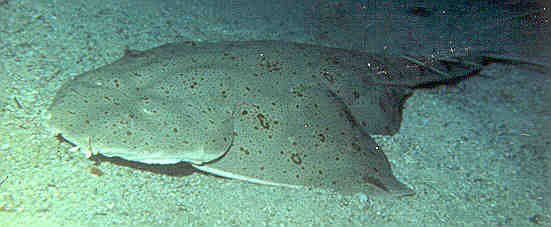
Common Name
Scalloped hammerhead
Scientific Name
Sphyrna lewini
Main Threats
The scalloped hammerhead is threatend by fisheries. It is sought for its fins, hide, flesh and liveroil.
Habitat
Inhabit deepwaters of continental and insular shelves, often found close to the coast and entering bays and estuaries. Depth range: 0 – 1043m.
LifeSpan
35 years
weight
80 – 100 kg
Length
3.6 m
DIET
Teleost fishes, cephalopods, lobters, shrimps, crabs, other sharks and rays
status (iucn)
Critically endangered
POPULATION TRENDS
Decreasing
further information
This species have 360º vision due to the position of their eyes, situated on the end of their heads. They also congregate in large schools during annual migration.
is fishing allowed in greece?
No
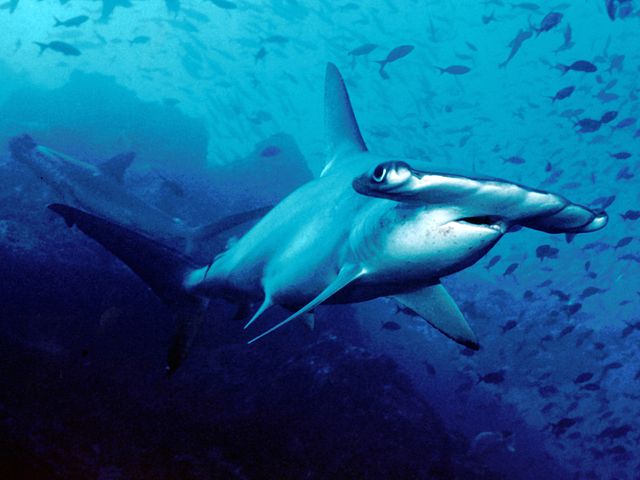

Common Name
Sharpnose sevengill shark
Scientific Name
Heptranchias perlo
Main Threats
Targeted by fisheries for liver oil
Habitat
Found on the outer continental and insular shelves and upper slopes. Depth range: 0 -1000 m.
LifeSpan
Unknown
weight
Unknown
Length
1 m
DIET
Small sharks, small rays, small bony fish, shrimps, crabs, lobsters, squid and cuttlefish.
status (iucn)
Near threatened
POPULATION TRENDS
Decreasing
further information
This species has seven instead of five pairs of gill slits
is fishing allowed in greece?
Yes
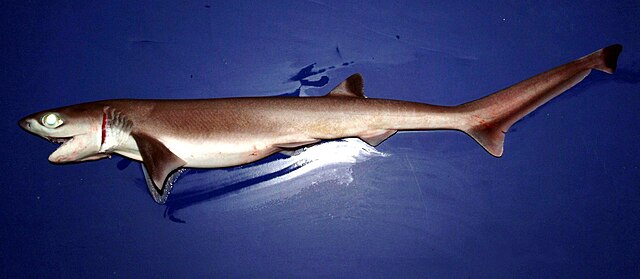

Common Name
Shortfin mako shark
Scientific Name
Isurus oxyrinchus
Main Threats
Shortfin makos are threatened by both targetted catch and bycatch of fisheries.
Habitat
Oceanic species found offshore and ocasionally in coastal waters. Depth range: 0 – 888 m.
LifeSpan
30 years
weight
570 kg
Length
2.7 m
DIET
Bluefish, swordfish, tuna, cephalopods
status (iucn)
Endangered
POPULATION TRENDS
Decreasing
further information
The shortfin mako is the fastest shark on the planet
is fishing allowed in greece?
Yes
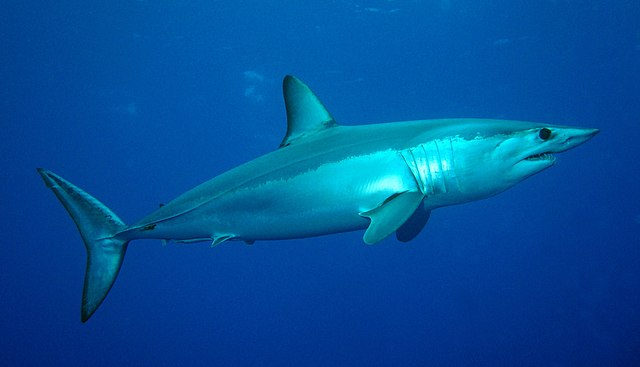

Common Name
Smalltooth sandtiger
Scientific Name
Odontaspis ferox
Main Threats
This species is targeted by fisheries for its liver and meat.
Habitat
Decreasing
LifeSpan
Unknown
weight
280 kg
Length
Small bony fishes, squids, crustaceans
DIET
Bony fish, crustaceans, mollusks, and cephalapods.
status (iucn)
Vulnerable
POPULATION TRENDS
Decreasing
further information
When confronted, these sharks have been observed to stall, gape their mouths, turn around, and shake their tails towards the perceived threat.
is fishing allowed in greece?
No
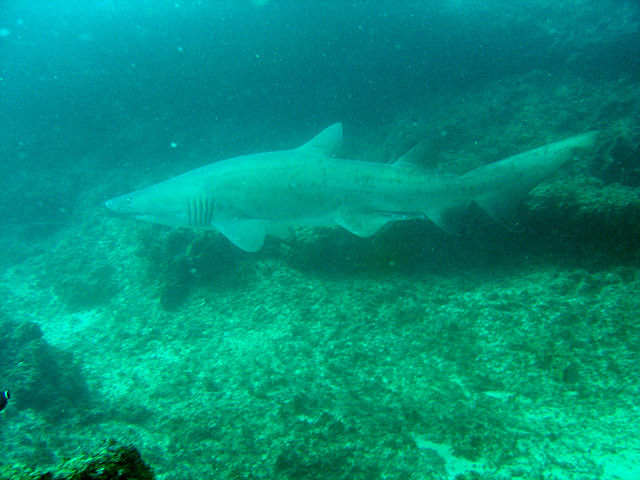

Common Name
Smooth hammerhead
Scientific Name
Sphyrna zygaena
Main Threats
The smooth hammerhead is being threatened by fisheries, it’s being harvested for its meat, hide, liveroil and fins.
Habitat
Found inshore and well offshore over contintental and insular shelves. Coastal, semi-oceanic, and pelagic species, but often associated with the seafloor. Depth range: 0 – 200m
LifeSpan
20 years
weight
400 kg
Length
3.35 m
DIET
Preference to small sharks, skates and stingrays, but also preys on bony fishes, shrimps, crabs, barnacles and cephalopods.
status (iucn)
Vulnerable
POPULATION TRENDS
Decreasing
further information
This species have 360º vision due to the position of their eyes, situated on the end of their heads. They also congregate in large schools during annual migration.
is fishing allowed in greece?
No


Common Name
Smooth-hound
Scientific Name
Mustelus mustelus
Main Threats
Targeted by anglers for oil and flesh.
Habitat
Demersal species that inhabit the continental shelves and uppermost slopes. Depth range: 5 – 624m.
LifeSpan
24 years
weight
Unknown
Length
1 m
DIET
Crustaceans, cephalopods, bony fishes
status (iucn)
Endangered
POPULATION TRENDS
Decreasing
further information
Like other smooth-hound sharks, the common smooth-hound aggregates in large numbers, like a pack of dogs, so they are called hounds.
is fishing allowed in greece?
Yes


Common Name
Smoothback angelshark
Scientific Name
Squatina oculata
Main Threats
Targeted for flesh, hide and liver oil
Habitat
Inhabits muddy and sandy substrates of contintental shelves and upper slopes. Depth range: 5 – 500 m.
LifeSpan
Unknown
weight
Unknown
Length
1.2 m
DIET
Small fishes
status (iucn)
Critically endangered
POPULATION TRENDS
Decreasing
further information
It has strong spines on its head and a characteristic colouring, with white ocellated spots.
is fishing allowed in greece?
No
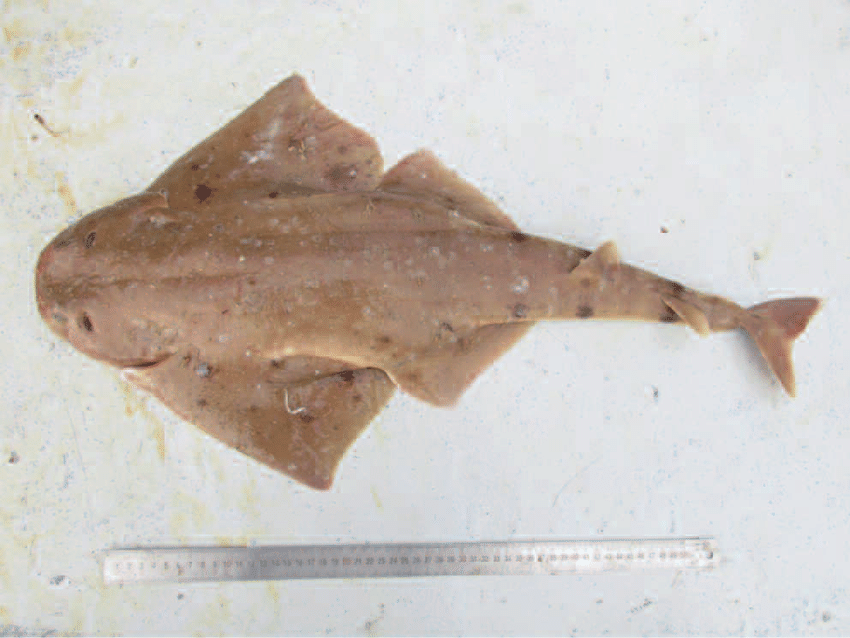
Common Name
Spiny butterfly ray
Scientific Name
Gymnura altavela
Main Threats
Bycatch
Habitat
Inhabits muddy and sandy substrates. Depth range: 5 – 100 m.
LifeSpan
Unknown
weight
60 kg
Length
2 m
DIET
Crustaceans, fisihes, molluscs, plankton
status (iucn)
Endangered
POPULATION TRENDS
Decreasing
further information
Spiny Butterfly rays are active predators. They usually approach their prey slowly before they quickly spin around and strike them with pectoral fin. Their pectoral fins have a high proportion of muscle and can deliver a strong blow, so butterfly rays can stun their preys in that way
is fishing allowed in greece?
No


Common Name
Starry smooth-hound
Scientific Name
Mustelus asterias
Main Threats
Targeted by fisheries for its flesh.
Habitat
Demersal species, found on the continental and insular shelves, preferring sandy and gravel bottoms. Depth range: 0 – 350m.
LifeSpan
Unknown
weight
4.8 kg
Length
1.5 m
DIET
Crustaceans
status (iucn)
Near-threatened
POPULATION TRENDS
Decreasing
further information
This shark has inspired the creation of some innovative technologies. Its skin has been used as a model for creating antibacterial, hydro/aerodynamic and antifouling clothing; its fins have helped to improve the stability of airplanes thanks to “sharklets” and the shape of its tail has served as inspiration for tidal steam generators.
is fishing allowed in greece?
Yes
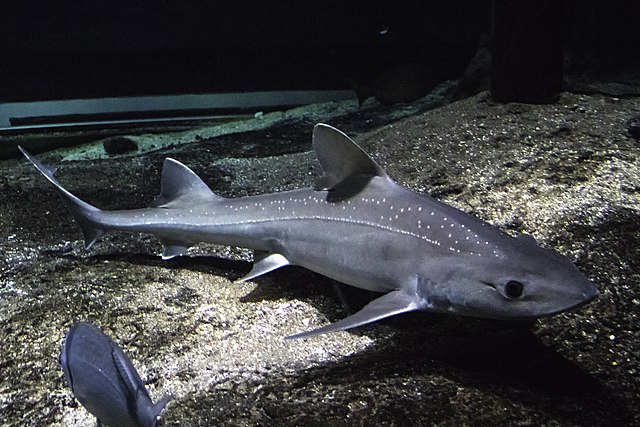
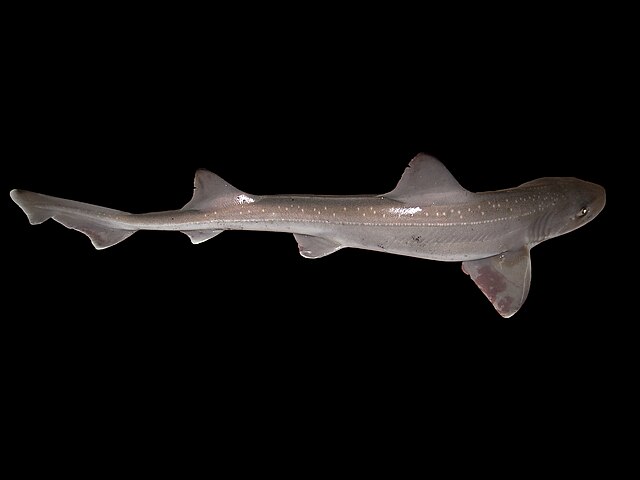
Common Name
Thresher shark
Scientific Name
Alopias vulpinus
Main Threats
This species is targeted by fisheries for its liver, hide, fins and meat.
Habitat
Pelagic species, found in open waters over continental shelves, but more abundant close to the shore. Depth range: 0 – 650m.
LifeSpan
25 years
weight
348 kg
Length
4.5 m
DIET
Schooling fishes, squid, octopus, pelagic crustaceans (rarely seabirds)
status (iucn)
Endangered
POPULATION TRENDS
Decreasing
further information
Their caudal fin has an extremely long upper lobe, which is about half of total body length
is fishing allowed in greece?
Yes


Common Name
Tope
Scientific Name
Galeorhinus galeus
Main Threats
Targeted for flesh, fins and liver oil
Habitat
Mostly demersal on continental and insular shelves, but also found on the upper slopes. Depth range: 0 – 1100 m.
LifeSpan
55 years
weight
44.7 kg
Length
1.6 m
DIET
Fishes, crustaceans, cephalopods, echinoderms
status (iucn)
Critically endangered
POPULATION TRENDS
Decreasing
further information
The only member of the genus Galeorhinus
is fishing allowed in greece?
Yes
